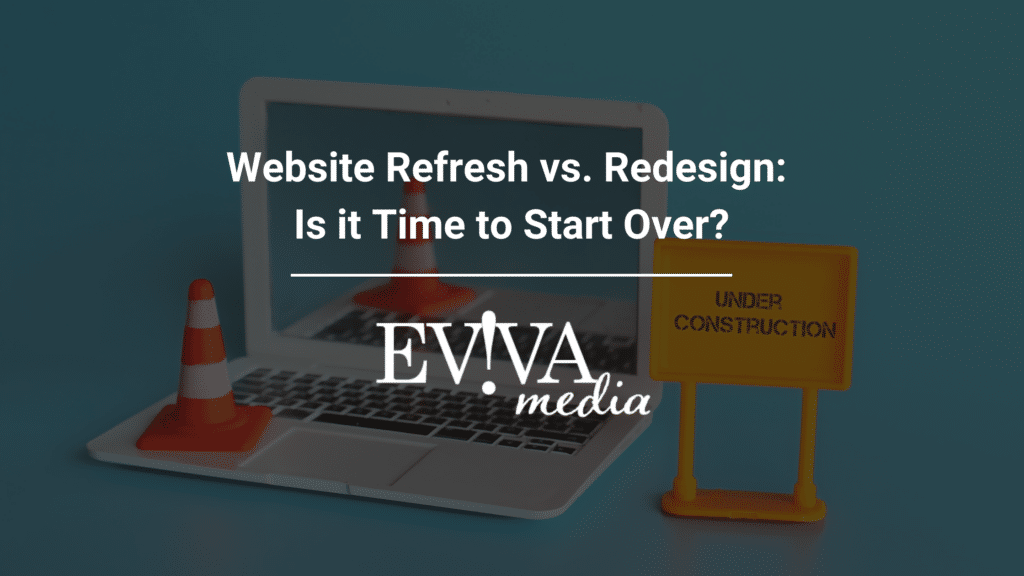As arguably one of the most important parts of your business, your website holds a lot of power. It’s the digital storefront of your business and needs to be in tip-top shape to attract and retain customers. But how do you know when it’s time for some minor tweaks or a complete overhaul? When debating between a simple website refresh or a full website redesign, there’s lots to consider! Let’s explore, shall we?
What is a Website Refresh? What About a Redesign?
So, what exactly is a website refresh? This typically involves making a few minor cosmetic changes to your current site. It’s like giving your website a new coat of paint without changing the fundamentals of what’s underneath.
On the other hand, a website redesign is a more in-depth process, akin to tearing down your old house and building a new one from scratch. Maybe you’ve got digital ‘termites’ and starting from scratch will be cost-effective and help you create the new foundation you’ve been looking for.
But, how to decide?! Let’s explore some of the signs that will let you know when you need a quick cosmetic fix or if the ‘termites’ have truly taken over…
5 Signs Your Website Needs a Refresh
1. Slow Load Speed
If your website takes longer than three seconds to load, it’s time for a refresh. Today’s online users expect instant gratification and slow load times can lead to high bounce rates (aka people leaving your site).
Not sure how long your site takes to load? There are tons of free tools available to check, including PageSpeed tools from Google.
2. Old Content
If you were to walk into a grocery store and all the food on the shelves was three years old, would you buy it? The same can be said about old website content.
Outdated content can be a sign that your website needs a refresh. If your blog posts are years old or your “latest news” is from 2018, it’s time to spruce things up. Potential customers might look at your old content and think your business is outdated or not even running anymore!
3. Poor User Experience
User experience (UX) refers to the overall experience a person has while interacting with your website.
Here are some questions that will help you determine how good your user experience is:
- Are there links on your website that lead to 404 pages (aka error pages)?
- Are your menus easy to understand and navigate?
- Is the text super small and hard to read?
- Do you have bad or grainy images?
Besides these questions, signs of poor UX include high bounce rates, low time on site, and negative user feedback. If your website provides a poor user experience, visitors are likely to leave quickly without converting and thus taking their business elsewhere–definitely NOT what you want.
4. Low Conversion Rates
Conversion Rate is the percentage of visitors to your website that complete a desired goal (a conversion) out of the total number of visitors. A high conversion rate is indicative of successful marketing and web designmeaning people want what you’re offering, and they’re easily able to get it!
If your website is experiencing low conversion rates, it could be a sign that certain elements on your site are not effectively engaging users or driving them to take action. This could be due to issues such as poorly written copy, confusing navigation, unattractive design, or ineffective calls to action .
5. Poor SEO Performance
Not just another marketing buzzword, Search Engine Optimization (SEO) is actually crucial for increasing your website’s visibility on search engines like Google. (And don’t forget Bing–a super under-rated platform for service-based businesses…) If your website isn’t showing up in search results, or if its rankings have dropped, it may be a sign that your SEO performance is lacking.
This could be due to a variety of issues, from slow site speed and broken links to duplicate content and poor keyword optimization. A website refresh can help address these issues by implementing SEO best practices, such as optimizing metadata, improving site speed, fixing broken links, and updating content with relevant keywords.
4 Signs It’s Time to Start from Scratch
Okay, so all of the above signs can be fixed with the help of a super digital marketing agency (hi, have you met Eviva Media?! We’d love to help…). But here are some red flags that indicate you’ve got digital ‘termites’ and it’s time to start from scratch.
1. Your Site is Not Mobile-Friendly
If your website isn’t mobile-friendly, it’s time for a new one. With over half of internet traffic coming from mobile devices, a non-mobile-friendly site will lose you a significant amount of potential business.
A lot of times, it can be challenging to make old websites mobile-friendly without starting from scratch and…well…monstrous.
2. Confusing or Outdated Site Architecture
Similarly, if your site architecture is confusing or outdated, a redesign is in order. Websites can sometimes turn into Doctor Frankenstein’s monster—adding different parts at different times to try to make things better can leave you with a site that’s actually worse than when you started.
A clear, intuitive layout is crucial for keeping visitors on your site and guiding them towards conversion.
3. Your Company Goals Have Changed
A significant shift in your brand or company goals also warrants a website redesign. Your website should reflect your current mission, values, and offerings.
4. Things Are Breaking!
Lastly, if the technology your website is built on is outdated and causing functionality issues, it’s time to start from scratch with a redesign. Often, older websites can also have a limit on how many security updates can be performed. Don’t leave yourself vulnerable to hackers all because of outdated security.
Pros & Cons of a Website Refresh vs Redesign
Both a refresh and redesign come with their own set of pros and cons. A refresh is usually quicker and cheaper, but it may not be enough if your site has major issues (think termites!)
A redesign, while more expensive and time-consuming, can give you a completely new, modern website built to your exact specifications, bringing you more traffic and conversions. Cons can include the time it takes to build a new site from scratch. The budget required for a full website redesign is usually higher, as well.
Debating Between a Refresh or Redesign?
When deciding between a refresh or redesign, consider your business goals, budget, and timeframe. If your website is generally performing well and just needs some updates, a refresh could be the best choice. However, if your site is outdated, confusing, or not aligned with your current business strategy, a redesign may be necessary.
Your website is a crucial part of your digital marketing strategy and running a successful business in this day and age, so it’s important to keep it updated and effective. Not sure whether your website needs a refresh or a redesign? That’s where we come in! Contact us today for a consultation, and let us help you make the most of your online presence.
Want to learn more? Check out our blog all about Template vs Custom Websites where we break down the difference between creating a new site customized for you or saving time and money with a pre-designed template.




